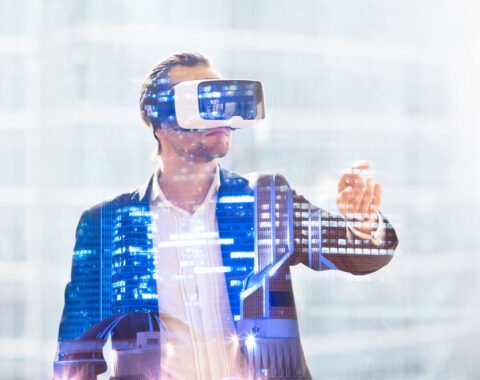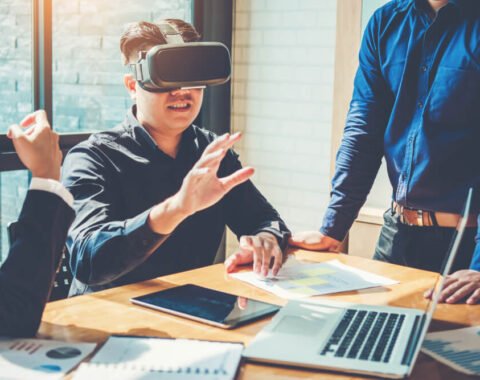Table of Contents:
Augmented reality has seen extreme growth in 2020. The COVID-19 pandemic made commercial use of the augmented reality technology explode and the AR industry is now worth as much as $15.3 billion. Experts keep saying that AR active devices are about to grow to 1.73 billion by 2024. If you are wondering what the miracle behind augmented reality is, imagine something that is not either an illusion or a reality. It’s a blend of both – and it’s absolutely amazing. So how does augmented reality work? How to create augmented reality and how is virtual reality different from augmented reality? Keep reading to find out.
What is augmented reality and how does it work?
Augmented reality is a powerful business technique that gives a user an interactive experience of the real-world environment. The technology usually includes sensory modalities – these may be visual presentations. The technique uses 3D registration of virtual and real objects. At the moment, augmented reality is one of the biggest technology trends and it seems that it’s only going to get bigger. The technology allows us to see the real-life environment with a digital augmentation overlaid on. Just imagine a park with trees swaying and… a dragon landing out there. This is just an example of how the AR world can look like. Of course, augmented reality is much more than just fun. It can be a powerful learning tool for e.g. medical professionals throughout their training. Or it can be part of your favorite shopping app that lets you try on clothes without even leaving home.
History of augmented reality
Augmented reality was first ‘discovered’ when the Sensorama was invented in 1957. It delivered sounds, vibration, smell and visuals to the viewer. It was the first example of adding additional data to an experience. Then, in 1968 computer scientist Ivan Sutherland at Harvard created an AR head-mounted display system. The system was advanced in the following decades by universities, national agencies and private companies. The first commercial use of augmented reality appeared in 2008. A German company created a printed magazine ad of a model BMW Mini a person could see also on the screen. The virtual model was connected to markets on the physical ad so the user could control and move the car on the screen. Since then, there have been some breakthroughs in augmented reality:
- In 2000 – an outdoor mobile AR game called ARQuake.
- In 2009 – ARToolkit being made available in Adobe Flash.
- In 2013 – open beta of Google Glass from Google.
- In 2015 – augmented reality support and AR headset HoloLens announced by Microsoft.
- 2018-2019 – 3D printing and AI.
How does augmented reality work – real use cases
First of all, you must have heard about the mobile app Pokemon Go. The game released back in 2016, instantly became a worldwide sensation. In the game, you track and capture Pokemons that pop in in the real world. In the park, on your sidewalk, at school. And Pokemon Go is a great example of augmented reality. Let’s be honest – today, most AR experiences are possible thanks to our smartphones and this is where augmented reality opens more and more possibilities. Besides gaming, what are the most popular uses of AR?
- Education – AR-based instructions are more effective than traditional methods like manuals. Augmented reality is widely used in training situations in military and healthcare industries that work on powerful AR simulations.
- Selling and shopping – you can try on or try out a variety of merchandise before buying. You can view cosmetics on your face, see particular furniture in your home or view colors on your walls. Especially now, during the pandemic, such solutions are game-changers for both customers staying at home and brands selling to shoppers stuck in their homes.
- Digital marketing – augmented reality changes the perception of customers. It makes the users’ experience more exciting in various areas – packaging, apps etc.
- Enhanced navigation systems that superimpose a route over the live view of the road.
- Entertainment – broadcasters use augmented reality e.g., during football games, to draw lines on the field to illustrate and analyze plays.
- History – AR can project views of ancient civilizations over today’s ruins on historical sites.
How is Virtual Reality different from augmented reality?
Shortly speaking, augmented reality uses the existing real-world environment and puts virtual information on top of it so that the experience is enhanced. On the other hand, Virtual Reality immerses a user in an entirely different environment created and rendered by computers. Virtual Reality can transport the user into a number of real-world and imagined environments. The technology gives the impression that the things the user sees have virtual existence. Augmented reality makes the user feel that surrounding parts are genuine while adding layers to the virtual environment. AR is approx. 25% virtual and 75% real, whereas VR is 75% virtual and 25% real.
Immersion
Augmented reality partially immerses the user into the action. VR fully immerses the user. However, in VR, the visual senses are under the control of the system. In AR, the user always has a sense of presence in the real world.
Practicalities
The augmented reality technology requires upwards of 100 Mbps bandwidth. No AR headset is needed, though. Virtual Reality requires at least a 50 Mbps connection. Some VR headset device is needed.
Staying in touch with the real world
AR makes it possible for the user to keep in touch with the real world while interacting with virtual objects nearer to them. On the other hand, the use of VR isolates the user from the real world and transfers them to a fictional one.
Main benefits
AR offers individualized learning and fosters the learning process in a wide variety of fields. It increases accuracy and offers innovation and continuous improvement. People can share experiences over long distances. VR offers immersive learning and creates an interactive environment. It increases work capabilities and makes education easier and more comfortable.
The future of augmented reality
Augmented reality is expected to flourish, and all experts agree that the most dynamic boost is still to come. What trends can we expect?
- Augmented reality in shopping and retail – virtual fitting rooms are no news. Its projected global market is expected to reach $10 billion by 2027. As AR matures, the comfort of consumers will only increase – imagine utilizing lighting conditions around the user, personalized advice and advanced facial recognition.
- Navigation – ARKit and ARCore based apps already help the customer find their way through airports, shopping malls and other locations. We hope in-store navigations to develop – this will help customers find exactly what they are looking for while shopping in-person. Also, in ARKit 4 Apple presented a tool for outdoor AR navigation called Geo Tracking. The tool uses a street view to ensure the best positioning.
- The automotive industry – augmented reality will serve multiple practical purposes for drivers – they will be able to process information that supports their view of the road. E.g., AR displaying virtual objects to a driver while on the road – this could be used to prepare drivers to stop for virtual hazards that appear in front of them.
- Events – career fairs, sports events – AR can help provide a unique experience to attendees. It can be used to create holograms of sports players that consumers can interact with in their own homes. For instance Major League Baseball in the US has been working to apply its innovative Hawk-Eye baseball tracking and analytics to AR experience.
On top of that, we cannot forget about mobile AR. There are Google Core and Apple ARKit 4 – both technologies have been making great strides to keep up in the industry. ARKit has now 950 million active users and ARCore 122 million. Some of the newest advances related to e.g. ARKit 4 include new depth API, improved face tracking and location anchors. Read also: What is difference between augmented reality and virtual reality.








